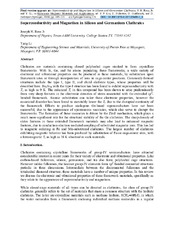| dc.description.abstract | Clathrates are materials containing closed polyhedral cages stacked to form crystalline frameworks. With Si, Ge, and Sn atoms populating these frameworks, a wide variety of electronic and vibrational properties can be produced in these materials, by substitution upon framework sites or through incorporation of ions in cage-center positions. Commonly-formed structures include the type I, type II, and chiral clathrate types, whose properties will be described here. Ba8Si46 with the type-I structure has been found to exhibit superconductivity with Tc as high as 9 K. The enhanced Tc in this compound has been shown to arise predominantly from very sharp features in the electronic densities of states associated with the extended sp3- bonded framework. Atomic substitution can tailor these electronic properties, however the associated disorder has been found to inevitably lower the Tc due to the disrupted continuity of the framework. Efforts to produce analogous Ge-based superconductors have not been successful, due to the appearance of spontaneous vacancies, which also serve to disrupt the frameworks. The formation of these vacancies is driven by the Zintl mechanism, which plays a much more significant role for the structural stability of the Ge clathrates. The sharp density of states features in these extended framework materials may also lead to enhanced magnetic features, due to conduction-electron mediated coupling of substituted magnetic ions. This has led to magnetic ordering in Fe and Mn-substituted clathrates. The largest number of clathrates exhibiting magnetic behavior has been produced by substitution of Eu on cage-center sites, with a ferromagnetic Tc as high as 38 K observed in such materials. | en |


